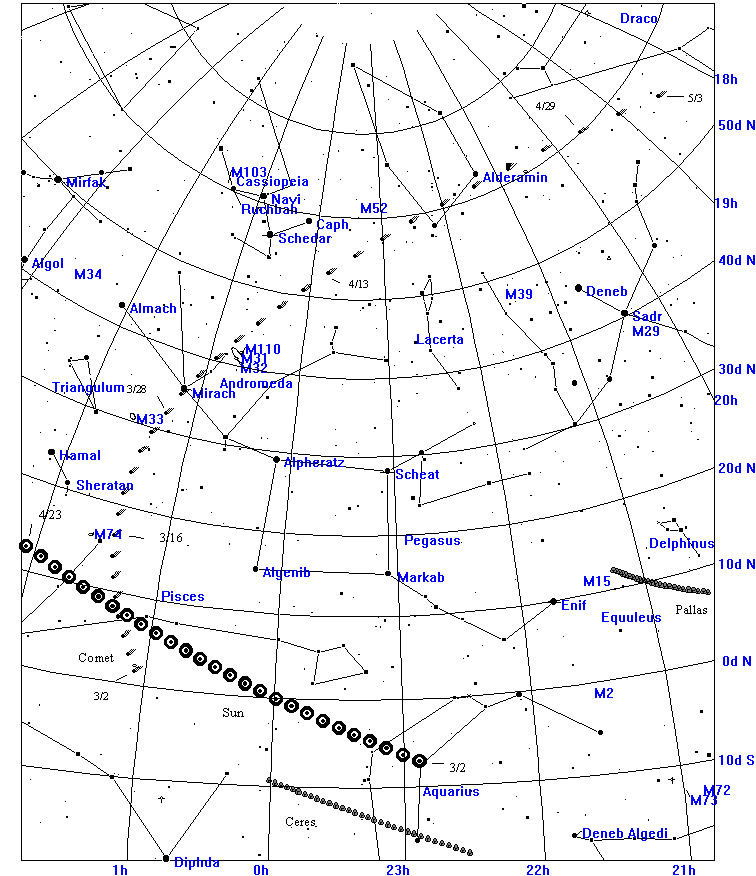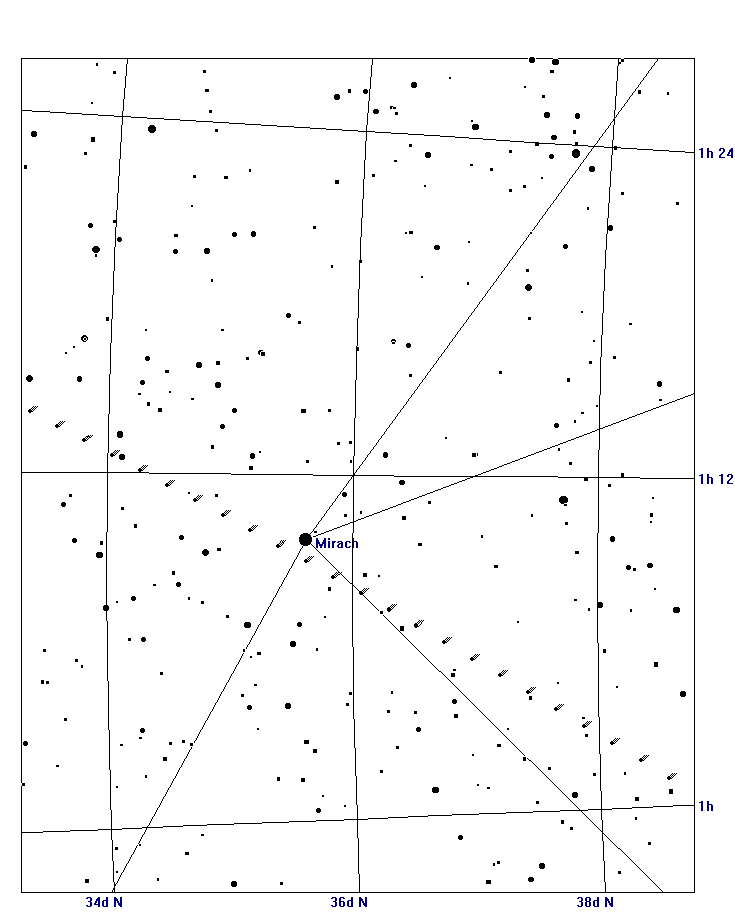
The following chart shows the path of the comet C/2002 C1 (Ikeya-Zhang);
it will be visible in Spring 2002 for observers in the Northern Hemisphere.
On the chart, each comet symbol ![]() depicts the location of the comet
every other day over the period March 2, 2002 to May 3, 2002. At
its brightest, the comet will be visible to the naked eye (provided you
view it from a dark location).
depicts the location of the comet
every other day over the period March 2, 2002 to May 3, 2002. At
its brightest, the comet will be visible to the naked eye (provided you
view it from a dark location).
The path of the Sun, and the paths of the asteroids Ceres and Pallas are also depicted in chart 1. Constellation names, bright stars and bright Messier objects are shown in blue. (Messier objects are indicated by the letter M followed by a number. Messier objects can be seen with small telescopes and many can be seen with binoculars, but most cannot be seen with the naked eye.)

The comet is positioned for evening viewing in the West before April 3. On March 16, the comet is positioned about 18 degrees above the horizon and at an azimuth angle of about 274 degrees at approximately 7:40 pm in the constellation Pisces.
Between March 18th and April 3 the movement of the comet is to the North while the sun’s daily motion reduces the altitude of the comet to about 13 to 14 degrees shortly after sunset when the comet first becomes visible.
After April 3 the comet is positioned to be observed in the morning sky. The daily motion of the comet is almost 90 degrees up from the morning horizon making it well positioned for viewing as the days progress after April 3rd.
The comet is at perihelion on March 18, about .5 au from the sun. Its expected that the tail will be at its maximum length on or within a few days after this date. The comet will reach its nearest point to the Earth on April 28, about .41 au. and therefore its observable size will be at the maximum.
It is predicted that the maximum brightness will occur after 3/18 and before 4/28, the nearest point to the Sun and Earth respectively. Between these dates the comet is receding from the Sun and approaching the Earth. A better estimate of when the comet is at maximum brightness is between 3/21 and 3/30.
After the date of maximum brightness and before 4/28 the comet will fade at a relatively slow rate. As the 4/28th date approaches and after this date the comet will fade at a very rapid rate.
Our Moon of course has to be taken into consideration when selecting the optimum viewing window/s for the comet. New Moon is 3/13, 4/12; 1st quarter is 3/21. 4/20; full Moon is 3/28 and 4/26; 3rd quarter is 4/4, 5/4. The Moon will be up when viewing the comet between 3/14 and a few days after full Moon on the 28th.
Between 3/ 30 and 4/3 the Moon will be below the horizon, but the comet will be low in the sky at sunset. After 4/3 when we switch to the morning sky to view the comet the moon will be up until 4/7. Between 4/7 and 4/25 the Moon is below the horizon and the comet is climbing higher in the sky on each succeeding morning making it (for some observers) a better window of opportunity to view the comet when it is reasonably bright. After 4/28 it will fade at a very rapid rate.

The above chart shows a position of the comet every 4 hours. It will be very close to Mirach on 3/30 and it will be a good opportunity to easily determine the comets position. Mirach is at magnitude 2.1 and the smallest dot is magnitude 9.9. If anyone has recorded the time/position of the comet or have taken pictures of the comet that time/position can be determined, please e-mail me. Thanks -- BF
Methods to Setup a Telescope and to Find Objects Close to the Horizon.
See IAU: Astronomical Headlines for more detailed information about this and other comets.